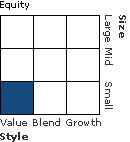|
| Release date as of 2025-09-30. Data on page is subject to change. |
|
|
Overall Morningstar
Rating™
|
| What is this?
|
|
 |
| As of 2025-09-30 |
|
Out of 462
Small Value Funds
|
|
|
|
|
|
| Total Fund Assets ($ Mil) |
| 686.91 |
|
|
|
| Investment Objective & Strategy |
|
| The investment seeks long-term growth of capital.
|
|
| The fund invests primarily in a diversified portfolio of equity securities of small- to mid-capitalization U.S. companies. It invests at least 80% of its net assets in securities of small- to mid-capitalization companies. For purposes of this policy, small- to mid-capitalization companies are those that, at the time of investment, fall within the capitalization range between the smallest company in the Russell 2500® Value Index and the greater of $5 billion or the market capitalization of the largest company in the Russell 2500® Value Index. |
|
|
| Morningstar Category: Small Value |
|
| Small-value portfolios invest in small U.S. companies with valuations and growth rates below other small-cap peers. Stocks in the bottom 10% of the capitalization of the U.S. equity market are defined as small cap. Value is defined based on low valuations (low price ratios and high dividend yields) and slow growth (low growth rates for earnings, sales, book value, and cash flow).
|
|
|
| Small Cap Funds: Smaller companies typically have higher risk of failure, and are not as well established as larger blue-chip companies. Historically, the smaller company stocks have experienced a greater degree of market volatility than the overall market average. |
|
|
| % of Net Assets |
 |
U.S. Stocks |
95.7 |
 |
Non-U.S. Stocks |
4.2 |
 |
Bonds |
0.0 |
 |
Cash |
0.2 |
 |
Other |
0.0 |
|
|
 |
| Data through 2025-08-31 |
|
|
|
|
| Morningstar Equity Sectors |
|
|
|
% of Stocks |
 |
Cyclical |
42.19 |
 |
Basic Materials |
5.07 |
 |
Consumer Cyclical |
10.40 |
 |
Financial Services |
18.29 |
 |
Real Estate |
8.43 |
|
|
|
 |
Sensitive |
41.61 |
 |
Communication Services |
2.17 |
 |
Energy |
5.18 |
 |
Industrials |
20.32 |
 |
Technology |
13.94 |
|
|
|
 |
Defensive |
16.20 |
 |
Consumer Defensive |
5.31 |
 |
Healthcare |
8.26 |
 |
Utilities |
2.63 |
|
| Data through 2025-08-31 |
|
|
| Total Number of Stock Holdings |
92 |
| Total Number of Bond Holdings |
0 |
| % of Net Assets in Top 10 Holdings |
15.78 |
|
|
| Turnover % |
(as of 2024-12-31) |
53.00 |
| 30 Day SEC Yield % |
--- |
|
|
Sector |
P/E |
% of Net
Assets
|
 |
 |
 |
 |
 |
|
BJ's Wholesale Club Holdings Inc |
 |
20.54 |
1.69 |
 |
NCR Atleos Corp |
 |
21.06 |
1.67 |
 |
Jones Lang LaSalle Inc |
 |
26.13 |
1.65 |
 |
Tenet Healthcare Corp |
 |
14.18 |
1.62 |
|
Encompass Health Corp |
 |
22.00 |
1.60 |
 |
|
Idacorp Inc |
 |
23.13 |
1.59 |
|
BorgWarner Inc |
 |
44.59 |
1.56 |
 |
RPM International Inc |
 |
20.32 |
1.50 |
|
The Hanover Insurance Group Inc |
 |
9.85 |
1.47 |
 |
Invesco Ltd |
 |
15.97 |
1.43 |
 |
|
 |
|
|
|
|
|
| Currency, Foreign Securities, Loss of Money, Not FDIC Insured, Capitalization, Active Management, Market/Market Volatility, Industry and Sector Investing, Derivatives |
|
| Show Risk Definitions |
|
|
| Inception Date: 2001-05-02 |
|
| Erik Turenchalk (2020-01-01) |
|
| To be provided. |
|
| James W. MacGregor (2005-12-30) |
|
| Chief Investment Officer—Small and Mid-Cap Value Equities
James MacGregor was appointed Chief Investment Officer of Small and Mid-Cap Value Equities in 2009. From 2009 to 2012, he also served as CIO of Canadian Value Equities. From 2004 to 2009, MacGregor was director of research of Small and Mid-Cap Value Equities, overseeing coverage of companies for the Small-Cap and Small/Mid-Cap Value services. He started as a research analyst covering the banking, energy, industrial commodity, transportation, and aerospace & defense industries for those same services. Prior to joining the firm in 1998, MacGregor was a sell-side research analyst at Morgan Stanley, where he covered US packaging and Canadian paper stocks. He holds a BA in economics from McGill University, an MSc in economics from the London School of Economics and an MBA from the University of Chicago. MacGregor is a CFA charterholder. Location: New York |
|
|
|
|
|
|
|
|
|
|
|
|

© Copyright 2025 Morningstar, Inc. All rights reserved. Morningstar, the Morningstar logo, Morningstar.com, Morningstar Tools are either trademark or service marks of Morningstar, Inc. The information contained herein: (1) is proprietary to Morningstar and/or its content providers; (2) may not be copied or distributed; and (3) is not warranted to be accurate, complete or timely. Neither Morningstar nor its content providers are responsible for any damages or any losses arising from any use of information. Past performance is no guarantee of future performance. |
|
Past performance is no guarantee of future results.
Returns will vary and shares may be worth more or less than their original cost when sold.
|
|





















